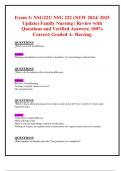Exam 3: NSG22 2/ NSG 22 2 (NEW 2024/ 2025 Update) Family Nursing | Review with Questions and Verified Answers| 100% Correct | Grade d A- Herzing QUESTIONS What is cervical insufficiency Answer: Thinning and dilation of cervix before it should be. Cervical changes without labor QUESTIONS What to do for patient with cervical insufficiency Answer: Bed rest, Trendelenburg Cerclage, surgical closure of cervix Give progesterone QUESTIONS What to know about placenta previa (what is mom at risk for? how to deliver? what exams cannot be done) Answer: Cannot have vaginal delivery Mom and baby vitals Mom at risk for hemorrhage, monitor for bleeding Nothing in Vagina, no vaginal exam or intercourse (no orgasm causes uterus to contract) QUESTIONS What happens in abruptio placenta? Can pregnancy be completed? Answer: Placenta tears away from uterine wall Cannot maintain pregnancy if it is a complete abruption, partial can monitor QUESTIONS What to monitor for and have with abruptio placenta Answer: Monitor for blood loss, contractions Need 2 IV lines (saline/meds and blood) Blood ready QUESTIONS Chronic Hypertension Answer: Hypertension that exists prior to pregnancy or that develops before 20 weeks' gestation with blood pressure readings greater than 140/90 mm Hg QUESTIONS Gestational Hypertension Answer: A new -onset blood pressure elevation (140/90 mm Hg) identified after 20 weeks' gestation without proteinuria; blood pressure returns to normal by 12 weeks' postpartum QUESTIONS Preeclampsia/HELLP Answer: Most common hypertensive disorder of pregnancy, which develops with proteinuria after 20 weeks' gestation; a multisystem disease process, which is accompanied by at least one of the following: proteinuria, elevated creatinine, liver involvement, epigastric or abdominal pain, neurologic complications, hematologic complications, and uteroplacental dysfunction; eclampsia occurs when seizure activity develops QUESTIONS What 4 things are given for HELLP Answer: Liver enzymes and platelets and Magnesium and Fluids QUESTIONS Main differences between gestational hypertension and preeclampsia Answer: Reflexes, vision changes, headaches in preeclampsia Preeclampsia has protein in urine QUESTIONS 2 phases of preeclampsia Answer: Preeclampsia is a two -stage event; the underlying mechanisms involved are vasospasm and hypoperfusion. In the first stage, the key feature is widespread vasospasm. In addition, endothelial injury occurs, leading to platelet adherence, fibrin deposition, an d the presence of schistocytes (fragments of erythrocytes). The second stage of preeclampsia is the woman's response to abnormal placentation, when symptoms appear (i.e., hypertension, proteinuria, headache, nausea and vomiting, retinal vascular changes ca using blurred vision, and hyperreflexia due to hypoperfusion). QUESTIONS Hyperemesis Gravidarum management Answer: Manage electrolytes and dehydration from vomiting I&Os Make sure they are gaining enough weight QUESTIONS Pathophysiology of Hyperemesis Gravidarum Answer: In hyperemesis gravidarum, the hCG levels are often higher and extend beyond the first trimester. Symptoms exacerbate the disease. Decreased fluid intake and prolonged vomiting cause dehydration; dehydration increases the serum concentration of hCG, which in turn exacerbates the nausea and vomiting QUESTIONS Hyperemesis Gravidarum Risk Answer: Bigger risk when you have had it previously in a pregnancy QUESTIONS Lab Results for HELLP Answer: Low hematocrit that is not explained by any blood loss Elevated LDH (liver impairment) Elevated AST (liver impairment) Elevated ALT (liver impairment) Elevated BUN (renal impairment) Elevated bilirubin level (liver impairment) Elevated uric acid and creatinine levels (renal involvement) Low platelet count (less than 100,000 cells/mm3)




